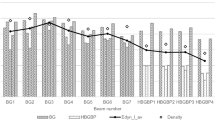Abstract
The authors investigated the properties of small-sized joint-free laminated beams (80 mm in width, 115 mm in height and 2 m in length) composed of 7 mechanically graded laminations of poplar (Populus x euramericana, 'Neva' clone) and eucalyptus (Eucalyptus grandis, '7', '329', '330' and '358' clones) in different combinations. Tests were carried out in order to determine their modulus of elasticity, bending strength and shear modulus; the bonding reliability was also evaluated by means of delamination and shear tests in the glue lines. The beams composed using the '330' eucalyptus clone, by its own or in combination with poplar, showed outstanding mechanical performance and the best structural efficiency. In addition the bonding quality, also at the interface between the two species, proved to be excellent. The results, separately for each clone of E. grandis, in terms of absolute values and structural efficiency, are shown and discussed.
Zusammenfassung
Die Autoren untersuchten die Eigenschaften von kleinen verbindungsfreien Brettschichtträgern (von 80 mm Breite, 115 mm in Höhe and 2 m Höhe) zusammengesetzt aus 7 mechanisch sortierten Brettschichthölzern von Pappel (Populus x euramericana, 'Neva' clone) und Eucalyptus (Eucalyptus grandis, '7', '329', '330' und '358' Klonen) in unterschiedlichen Kombinationen. Tests wurden durchgeführt, um ihr Elastizitätsmodul, ihre Biegefestigkeit und Scherfestigkeit zu bestimmen; die Haftverläßlichkeit wurde ebenfalls abgeschätzt durch Delaminierung und Schertests in den Klebefugen. Die zusammengestellten Balken, bei denen man den 330 Eukalyptusklon verwendete, entweder allein oder in Kombination mit Pappel, zeigten herausragende mechanische Qualität und die beste strukturelle Leistungsfähigkeit. Zusätzlich erwies sich die Bindefestigkeit, auch an den Grenzflächen zwischen den beiden Arten als exzellent. Es werden die Ergebnisse separat für jeden Klon von E. grandis, als absolute Werte und als strukturelle Leistungsfähigkeit dargestellt und diskutiert.





Similar content being viewed by others
References
Berti S, Brunetti M, Macchioni N (2000) Physical and mechanical characterization of Italian grown Eucalypts. Proceedings of International Conference "Eucalyptus in the Mediterranean Basin: Perspectives and new utilisation" (Taormina 15–19 October 2000)
Biblis EJ (1966) Design considerations for laminated wood beams composed of two species. Forest Prod J 16(7)
Biblis EJ (1967) Strength-weight and stiffness-weight ratios of two species wood beams. Forest Prod J 17(8)
Biblis EJ (1967) Shear deflection of two species laminated wood beams. Wood Sci Technol 1:231–238
Castro G, Paganini F (1993) Caratterizzazione fisico meccanica del legno di pioppo. Indagini condotte sui cloni di Populus x euramericana 'I 214' e 'BL Costanzo' [Physical-mechanical characterization of poplar wood. Research work carried out on Populus x euramericana clones 'I-214' and 'BL Costanzo']. Xilon 68:56–61
Castro G, Paganini F (1997) Parameters affecting end finger joint performance in poplar wood. Proceedings of the International Conference of IUFRO S 5.02 "Timber Engineering" (Copenhagen, 18–20 June 1997)
Castro G, Paganini F (1999) Poplar-Eucalyptus Glued Laminated Timber. Proceedings of EUROWOOD Technical Workshop "Industrial end-uses of fast-grown species" (Florence, May 31st–June 1st) 147:166
EN 386: Glued laminated timber—Performance requirements and minimum production requirements.
EN 391: Glued laminated timber—Delamination test of glue lines.
EN 392: Glued laminated timber—Shear test of glue lines.
EN 408: Timber structures—Structural timber and glued laminated timber—Determination of some physical and mechanical properties.
EN 1194: Timber structures—Glued laminated timber—Strength classes and determination of characteristic values
ENV 1995-1-1 (Eurocode 5)—Design of timber structures—Part 1-1: General rules and rules for buildings
Facciotto G, Castro G (1997) 'Lena' e 'Neva': due nuovi cloni per la pioppicoltura e l'industria [Two new poplar clones: 'Lena' and 'Neva']. Sherwood 28:17–21
ISO 3131: Wood. Determination of density for phisical and mechanical tests
ISO 3133: Wood. Determination of ultimate strength in static bending
ISO 3347: Wood. Determination of ultimate shearing stress parallel to grain
ISO 3787: Wood. Test methods. Determination of ultimate stress in compression parallel to grain
ISO 4469: Wood. Determination of radial and tangential shrinkage
Moody RC (1974) Design criteria for larger structural glued-laminated timber beams using mixed species of visual graded lumber. USDA Forest Service—Res. Paper, FPL, 236
Mori T, Asano I (1953) Study on the laminated wood beams composed of different species. Building Research Institute, Ministry of Construction, Japanese Government
Ozelton EC, Baird JA (1976) Timber designers' manual. Crosby Lockwood Staples, London
Pedrotti P, Paganini F, Castro G (1997) Impieghi del legno lamellare di pioppo per uso strutturale [Use of laminated poplar wood for structural purposes]. Xilon 5:102–110
Author information
Authors and Affiliations
Corresponding authors
Rights and permissions
About this article
Cite this article
Castro, G., Paganini, F. Mixed glued laminated timber of poplar and Eucalyptus grandis clones. Holz Roh Werkst 61, 291–298 (2003). https://doi.org/10.1007/s00107-003-0393-6
Published:
Issue Date:
DOI: https://doi.org/10.1007/s00107-003-0393-6




